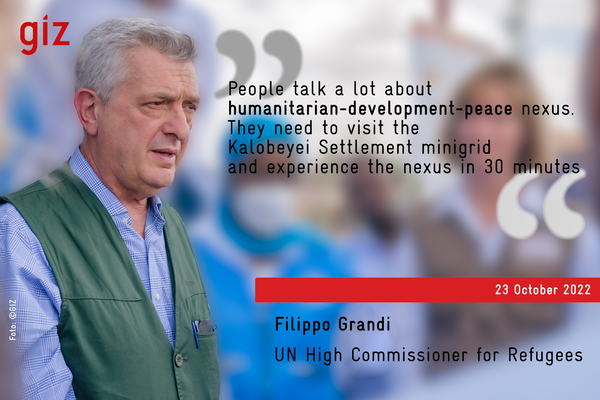Knowledge fuels change
For over a decade, Energypedia has shared free, reliable energy expertise with the world.
We’re now facing a serious funding gap.
Help keep this platform alive — your donation, big or small, truly matters!
Thank you for your support
Difference between revisions of "ESDS Electrification (Mini-Grids)"
***** (***** | *****) |
***** (***** | *****) |
||
| Line 13: | Line 13: | ||
https://www.youtube.com/watch?v=hkD_xKL40RM | https://www.youtube.com/watch?v=hkD_xKL40RM | ||
| − | This was done in parallel with the private mini-grid developer/operator - Renewvia Energy Limited’s expansion of the existing 60kWp solar mini-grid generation infrastructure. Prior to expansion, the ESDS project had provided technical and financial support in 2020 towards electrification of '''10 institutions''' in the refugee and host community that were earmarked to offer health and isolation services | + | This was done in parallel with the private mini-grid developer/operator - Renewvia Energy Limited’s expansion of the existing 60kWp solar mini-grid generation infrastructure. Prior to expansion, the ESDS project had provided technical and financial support in 2020 towards electrification of '''10 institutions''' in the refugee and host community that were earmarked to offer health and isolation services. Previously electrified institutions as part of COVID-19 response in 2020''',''' [[Expanding mini-grids during Covid-19 – Experiences from Kalobeyei]] : 3 health facilities, 4 schools, 2 Accommodation facilities, 1 WFP greenhouse. |
The SUN-ESDS Kenya project has also provided feasibility studies to support potential mini-grid developers. Increased energy access through the mini-grid systems presents the opportunity for the host community and refugee residents, businesses, and institutions in Kalobeyei to expand their electricity usage to livelihood and income generation activities; so-called [[Promoting Productive Use of Electricity in Displacement settings]] . This report presents the state of PUE in Kalobeyei, the design and campaign activities and, lastly, identifies the recommendations for replication in displacement settings. | The SUN-ESDS Kenya project has also provided feasibility studies to support potential mini-grid developers. Increased energy access through the mini-grid systems presents the opportunity for the host community and refugee residents, businesses, and institutions in Kalobeyei to expand their electricity usage to livelihood and income generation activities; so-called [[Promoting Productive Use of Electricity in Displacement settings]] . This report presents the state of PUE in Kalobeyei, the design and campaign activities and, lastly, identifies the recommendations for replication in displacement settings. | ||
Revision as of 09:44, 5 May 2023
Mini-grids
![]()
The SUN-ESDS focuses on market-based energy solutions by providing global advisory services, implementing technical and financial measures and cooperating with relevant stakeholders in order to provide Access to energy for livelihoods in displacement settings. In Kenya, project seeks to address the lack of a sustainable energy supply in Kalobeyei Settlement in Turkana West Subcounty, which hosts 3,500 host community members and 47,700 refugees respectively. The SUN-ESDS provided both technical and financial assistance for the construction of more than 40 km of low and medium voltage power distribution lines in Kenya's Kalobeyei Settlement. It has 1.1 MWh of lithium-ion battery storage and a 150 KVA backup generator. At least 2,200 connections (1,929 households, 275 businesses, and 17 social institutions) are now served by the expanded mini-grid and more than 10,000 people are benefitting from these connections.
On 23 October 2022, UNHCR High Commissioner, Mr Filippo Grandi, visited the newly expanded 541kWp Kalobeyei Settlement solar mini-grid. The mini-grid serves as a classic example of how the humanitarian-development-peace nexus can be operationalized to provide sustainable solutions to both refugees and host communities. Grandi emphasised:SUN-ESDS Contributes to High Tier Electricity Supply in Kalobeyei:
https://www.youtube.com/watch?v=hkD_xKL40RM
This was done in parallel with the private mini-grid developer/operator - Renewvia Energy Limited’s expansion of the existing 60kWp solar mini-grid generation infrastructure. Prior to expansion, the ESDS project had provided technical and financial support in 2020 towards electrification of 10 institutions in the refugee and host community that were earmarked to offer health and isolation services. Previously electrified institutions as part of COVID-19 response in 2020, Expanding mini-grids during Covid-19 – Experiences from Kalobeyei : 3 health facilities, 4 schools, 2 Accommodation facilities, 1 WFP greenhouse.
The SUN-ESDS Kenya project has also provided feasibility studies to support potential mini-grid developers. Increased energy access through the mini-grid systems presents the opportunity for the host community and refugee residents, businesses, and institutions in Kalobeyei to expand their electricity usage to livelihood and income generation activities; so-called Promoting Productive Use of Electricity in Displacement settings . This report presents the state of PUE in Kalobeyei, the design and campaign activities and, lastly, identifies the recommendations for replication in displacement settings.




















